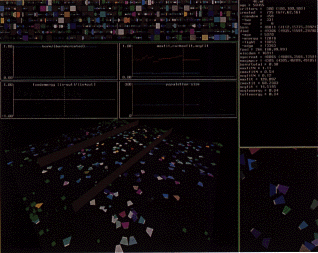
While much of the work with evolution in the digital medium has had clear engineering objectives, some work has simply been an exploration of the process of evolution in an unfamiliar medium. In this latter case, the conditions are created for free evolution by natural selection to take place among self-replicating computer programs. The result is an unguided diversifying phylogeny of ``digital organisms'', in an ecological community within cyberspace.
Larry Yaeger [42] set up a genetic algorithm based systems called PolyWorld which evolved freely by natural selection. The GA defined the characteristics of ``organisms'' which exist on a simulated flat surface which may have some barriers on it. There is also ``food'' distributed on the surface.
Figure 5:
Screen shot of PolyWorld Ecological Simulator.
(from: Yaeger, Larry. 1994. Computational genetics, physiology, metabolism,
neural systems, learning, vision, and behavior or PolyWorld:
life in a new context. In: Artificial Life III,
[Ed.] Christopher G. Langton, SFI Studies in the Sciences of
Complexity, Proc. Vol. XVII, Addison-Wesley. Pp. 263--298.)

The organisms have colored polygonal bodies, visual systems, and neural networks that employ Hebbian learning at their synapses. The output of the neural networks fully determine the organisms behavior, by having prespecified neurons whose output level determines the activation for seven behaviors: eating, mating, fighting, moving, turning, focusing, lighting. All behaviors, including the activity of the neural net, consume energy, which can be replenished by eating food.
The GA bit string defines the structural and some functional characteristics of the organisms by providing values for the following: size, strength, maximum speed, green color value, mutation rate, life span, fraction of energy to offspring, and eleven characteristics of the neural network.
PolyWorld can be initially seeded by randomly generated genomes. Sometimes these fail to reproduce effectively and the world dies out. Other times stable populations establish themselves, and a variety of behaviors and ecologies emerged.